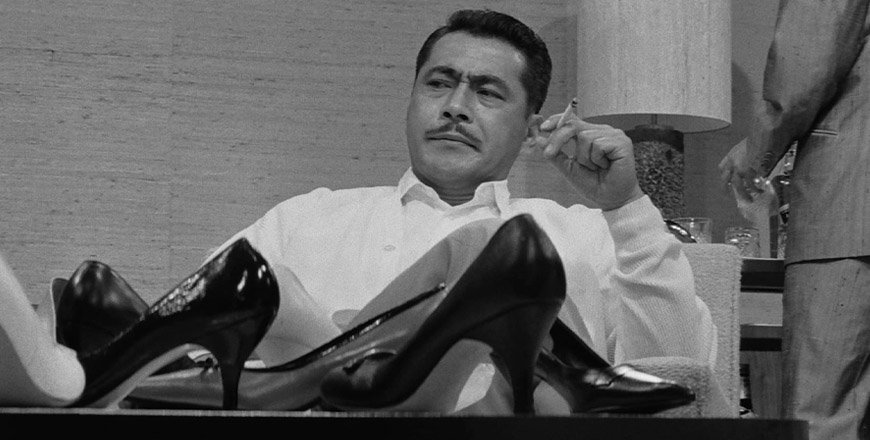Bright Light, Dark Shadow: High and Low
By 1963, Japan is a revitalized nation of industry and commerce, a decade past its Occupation by Allied Forces. It is a nation that no longer wonders how to survive; instead, it deliberates upon how best to live in its renewal. Yet, for those who enjoy the luxury of success, there are those who suffer the poverty of failure in this class-based society. Having already explored the criminal morality of post-World War II Japan in Stray Dog (1949), Akira Kurosawa returns to the theme of duality in High and Low (1963), which screened as part of Austin Film Society’s Newly Restored Kurosawa series.
The opening shot of the film is an image of an industrious Japan from above, with its factories’ chimneys smoking with active production. The audience soon sees this view from the balcony of shoe executive Kingo Gondo (Toshiro Mifune). From his high perspective, Gondo looks upon his future with eagerness as he plots a corporate takeover of his employer to confirm his ownership of the company. Even though his company’s product is shoes, business is business, and Gondo is a cutthroat strategist. As he observes his son playing Sherriff & Outlaw with the chauffeur's child, he provides the advice of “hide and then ambush the sheriff.”
The first hour of the film takes place in Gondo’s luxurious residence. The film is almost like a theatrical production in its limited set. The choreography of its characters that enter-and-depart Gondo’s opulent home, from rival executives to children playing to arriving detectives, mirrors the film’s swift plot movement. Just moments after enjoying a celebratory toast to his presumed success, Gondo receives a phone call from a child kidnapper who demands ransom, even though the villain has taken the chauffeur’s son by mistake. Whereas the first portion of the film commences as a corporate coup from the confines of a living room, upon notice of the kidnapping, High and Low proceeds as a police procedural.
As indicated by the film’s title, there exists a duality in the structure of the movie. The shift in scenes from an opulent residence to underprivileged abodes is striking. This descent is purposeful in Kurosawa’s examination of this class-based society, as the plot now explores the culture it had only previously seen from above. This is a world that features both shoe executives in tailored suits and furnace attendants dirtied from daily trash disposal. Leading the kidnapping investigation is clever Inspector Tokura (Tatsuya Nakadai), who is sympathetic to Gondo’s plight. Tokura is inspired not only to serve justice but also to protect Gondo from a potential destitution. Essentially, Tokura serves as co-leading character as the investigation to discover the kidnapper takes prominence in the film’s plot. Tokura’s team of detectives scours over the city in search of clues, noting that Gondo’s house on the hilltop must incite resentment from those who view it from below. Thus, the duality of class distinction via accumulated wealth inspires criminal motivation.
High and Low asks: what cost is the soul of a man? Gondo’s deputy tells him “I know how much this money means to you, but human life means more” as Gondo deliberates paying the ransom demand for a child that is not even his own. Doing so would prove disastrous for his scheme of corporate takeover. He rebuts his deputy by saying “what happened to the cold-hearted businessman?” By establishing Gondo as a determined executive to succeed, Kurosawa sets his character in comparison to the kidnapper. Both are intelligent figures, driven to prosper by way of intrigue; for Gondo, to take over the shoe company in secrecy; for the villain, to ensnare Gondo’s wealth by way of a dastardly crime.
Yet, Gondo’s desire for control in the shoe company is to still make excellent shoes at affordable prices, much to his business rivals’ chagrin. Gondo’s potential success ensures the preservation of quality for all. An expert in footwear, Gondo knows that “shoes carry all [the] weight” for an individual. Instead, the kidnapper wishes to profit alone, even murdering those who assist him in his extortion scheme. Though Gondo and the kidnapper are similar in their determination, they are opposite in their considerations for others’ wellbeing. Hence, Gondo acquiesces to the ransom demand, to sacrifice his success to save the life of another. Gondo’s light is in sharp opposition to the dark shadow cast by the villain, enhancing the duality found in High and Low.
As Tokura’s investigation continues to discover the identity of the kidnapper-now-killer, his understanding of the villain’s motivation develops. The detectives discover the kidnapper’s occupation is a career whose creed is to “do no harm”, further illustrating the antagonist’s villainy. Once the kidnapper’s identity is discovered, the detectives wait to catch Ginjirō Takeuchi (Tsutomu Yamazaki) commit a worse crime that will extend his punishment. The detectives’ surveillance of Takeuchi takes the audience further down to the lowest depths of this Japanese culture. From a drug handoff during a dance sequence (all to that dangerous music once called rock n’ roll) to visiting an addicts’ den, the policemen visit the hell that Takeuchi comes from, the class-based society that inspires him to hate those above, in particular Gondo. In an effective sequence of music design, the policemen entrap Takeuchi all to an instrumental version of Elvis Presley’s “It’s Now or Never” (itself a version of the Italian “O Sole Mio”).
The conclusion of this film features a meeting between Gondo and Takeuchi, the intended victim and perpetrator. It is an interesting scene, as Gondo does not admonish his extortionist for his crimes. Instead, Gondo asks, “Why should you and I hate each other?” Kurosawa, an expert in Western culture, must have been inspired by Shakespeare’s Iago. In Othello, Iago states, “Demand me nothing; what you know, you know” as defense for his heinous actions. Likewise, Takeuchi offers in reply, “I don’t know . . . Your house looked like heaven, high up there. That’s how I began to hate you.”
High and Low offers the duality of class-based society in this crime drama. It screens in August 2025 as part of the Newly-Restored Kurosawa series at Austin Film Society.
If you enjoyed this article, please consider becoming a patron of Hyperreal Film Journal for as low as $3 a month!




Paul Feinstein is an arts professional who has produced content in different mediums including film screenings, live music, radio, and theater. He is a native Austinite.